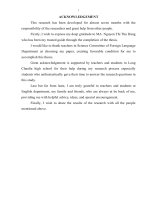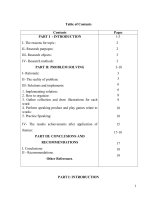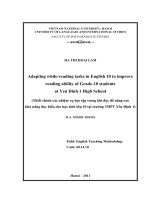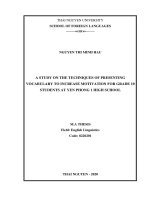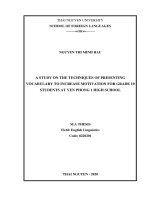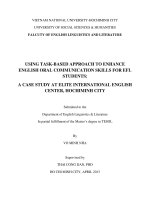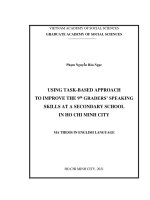Using task based approach to improve student’s reading comprehension for grade 10 students at viet tri industrial high school
Bạn đang xem bản rút gọn của tài liệu. Xem và tải ngay bản đầy đủ của tài liệu tại đây (961 KB, 89 trang )
HUNG VUONG UNIVERSITY
DEPARTMENT OF FOREIGN LANGUAGES
PHUNG THI THANH TAM
USING TASK-BASED APPROACH TO IMPROVE STUDENT’S
READING COMPREHENSION FOR GRADE 10 STUDENTS
AT VIET TRI INDUSTRIAL HIGH SCHOOL
(Sử dựng phương pháp dạy học dựa trên những nhiệm vụ thực tế nhằm cải thiện
kỹ năng đọc hiểu cho học sinh lớp 10 Trường THPT Công Nghiệp Việt Trì)
B.A. GRADUATION PAPER
Field: English Methodology
Supervisor: DANG LUU NGOC HOA, M.A
PHU THO, 2021
ACKNOWLEGGEMENT
I would like to express my sincerest thanks to those who helped me to complete
this graduation paper.
First of all, I would like to thank M.A Dang Luu Ngoc Hoa for her help and
guidance, helping me to complete my research paper. She guided and gave insightful
comments to make my research more complete.
I would like to acknowledge my thank to all lecturers of the Foreign Lnaguage
Department at Hung Vuong University for their useful materials, guidance during my
research.
My special thanks also go to Viet Tri Industrial high school‟s teachers and
students who helped me a lot in my experiment. With their support, my study
completed successfully.
I also extend my sincere thanks to my family and friends. It was their love and
encouragement that gave me more confidence and the will to complete the research
The writer realizes that this thesis is still far from being perfect. The writer will
accept every comment and suggestion. Hopefully, this thesis will give benefit to
everyone who concerns with action research.
Viet Tri, May 2021
Phung Thi Thanh Tam
ii
ABSTRACT
The research was set out in the attempt to overcome the reading comprehension
of the students in grade 10 at Viet Tri Industrial high school. The research is also
aimed to know whether or not the task- based approach can improve the students‟
reading comprehension
and the students‟ attitude toward the use of task-based approach in improving their
reading comprehension.
The participant includes 74 students in class 10A and 10G at Viet Tri Industrial
high school. The data were collected from survey questionnaire, pre-test and pro-test
for students. Based on the result above, the researcher recommended some suggestions
for teachers and students to help them apply task-based approach in teaching and
learning reading comprehension more effectively.
The study includes three main parts: Part 1: Introduction, Part 2: Content, Part 3:
Conclusion. The result of the study showed that task-based learning can improve
students reading comprehension. Using task-based learning has raised students‟
interest in reading. They were also actively involved in the teaching and learning
process. Most of them were able to engage in activities that either helps them to recall
words and phrases that will be useful during the performance of the main task or to
learn new words and phrases that are essential to the task. Their group work also
enhanced since the researcher gave them group work project to finish their works.
There was significant improvement of the mean scores of their reading comprehension
from pre-test, post-test, task-based learning also improved the class situation, such as
more enjoyable class environment, increasing students‟ participation, reducing
teacher‟s domination, providing more chance for students to work in group.
Based on the result of the study, the researcher concluded that the students‟
reading comprehension and classroom situation can be improved by implementing the
task-based learning. Therefore, it is recommended that the teacher should apply the
task-based learning in teaching reading skill.
iii
Table of Contents
ACKNOWLEGGEMENT ....................................................................................................ii
ABSTRACT ....................................................................................................................... iii
LIST OF ABBREVIATIONS ............................................................................................. vi
LIST OF TABLES .............................................................................................................vii
LIST OF FIGURES .......................................................................................................... viii
PART A: INTRODUCTION ................................................................................................ 1
1. Rationale ........................................................................................................................... 1
2. Previous studies ................................................................................................................ 2
2.1. In the world ................................................................................................................ 2
2.2. In Viet Nam ............................................................................................................... 5
3. Research purposes ............................................................................................................ 5
4. Research questions ........................................................................................................... 6
5. Research method............................................................................................................... 6
6. Significance of the research.............................................................................................. 6
6.1. Scientific significance ............................................................................................... 6
6.2. Practical significance ................................................................................................. 6
7. Research scope ................................................................................................................. 7
PART B. CONTENT ............................................................................................................ 8
CHAPTER 1. THEORETICAL BACKGROUND .............................................................. 8
1. Theoretical background of reading skill ........................................................................... 8
1.1. Definition of reading skill ......................................................................................... 8
1.2. Types of reading ........................................................................................................ 9
1.3. Reading process ....................................................................................................... 11
1.4. Stages of teaching reading skill ............................................................................... 13
1.5. What is reading comprehension?............................................................................. 14
1.5.1. Definition of reading comprehension ............................................................... 14
1.5.2. Strategies on Reading Comprehension............................................................. 15
1.6. Factors affecting reading comprehension............................................................ 16
2. An overview of task-based approach ............................................................................. 19
2.1. Definition of task ..................................................................................................... 19
2.2. Definition of task-based approach ........................................................................... 21
2.3. The task framework ................................................................................................. 22
2.4. The advantages of Task-based approach in teaching reading ................................. 26
CHAPTER 2. METHODOLOGY ...................................................................................... 28
iv
2.1. Research setting ....................................................................................................... 28
2.2. Participants of the research ...................................................................................... 29
2.3. Data collection instruments ..................................................................................... 30
2.3.1. Survey questionnaires ....................................................................................... 30
2.3.2. Tests: Pre-test, Post-test.................................................................................... 31
2.4. Data collection procedure ........................................................................................ 32
2.5. Data analysis ............................................................................................................ 34
CHAPTER 3. FINDINGS AND DISCUSSION ................................................................ 37
3.1. To what extent can task-based approach improve students‟s reading
comprehension? .............................................................................................................. 37
3.1.1. General opinions of students on reading .......................................................... 37
3.1.2. General opinions of students on task-based approach on reading
comprehension ............................................................................................................ 43
3.2. What are the students‟ attitude toward the use of task-based approach in
improving their reading comprehension? ....................................................................... 46
3.2.1. The pre-test results of the experimental group ................................................. 46
3.2.2. The post-test results of the experimental group ............................................... 47
3.2.3. The comparison of the pre-test and post-test result in experimental group ..... 49
3.3. The test results between the control and experimental groups ................................ 50
3.3.1. The results of pre-test between the control and experimental group ............... 50
3.3.2. The results of post-test between the control and experimental group .............. 51
CHAPTER 4. SUGGESTED SOLUTIONS ...................................................................... 53
PART C. CONCLUSION .................................................................................................. 55
1. Summary of major findings ............................................................................................ 55
2. Limitations of the Study ................................................................................................. 55
3. Implications for Further Research .................................................................................. 56
REFERENCES ................................................................................................................... 57
APPENDICE ...................................................................................................................... 60
APPENDIX 1A............................................................................................................... 60
APPENDIX 1B ............................................................................................................... 62
APPENDIX 2A. PRE-TEST .......................................................................................... 64
APPENDIX 2B. POST-TEST ........................................................................................ 68
APPENDIX 3A. LESSON PLAN .................................................................................. 71
APPENDIX 3B. LESSON PLAN .................................................................................. 75
APPENDIX 4A: Results of pretest and posttest for Group A (Control group) ............. 80
APPENDIX 4B: Results of pretest and posttest for Group B (Experimental group) .... 81
v
LIST OF ABBREVIATIONS
CBLT: Content-based language teaching
EFL: English as a Foreign Language
ELT: English language teaching
T: Teacher
TBL: Task-based learning
TBLT: task-based language teaching
Ss: Students
vi
LIST OF TABLES
Table 1. The comparison between extensive reading and intensive reading
Table 2. The System of Scores Category
Table 3. In your opinion, what are the benefits of using TBL activities in reading
lessons?
vii
LIST OF FIGURES
Figure 1. Structure of task-based approach (Nunan 2004)
Figure 2. Interactive Mode of Data Analysis (Miles and Huberman, 1992)
Figure 3. Do you think that reading skill in important?
Figure 4. What best describes the atmosphere in reading lessons? Can you clarify?
Figure 5. When you read, what are the difficult things for you?
Figure 6. What do you do while you are reading a text?
Figure 7. How do you rank your participation in reading lessons?
Figure 8. What difficulties did you encounter in TBL activities?
Figure 9. The pre-test results of the experimental group
Figure 10. The post-test results of the experimental group
Figure 11. The comparison of the pre-test and post-test result in experimental group
Figure 12. The results of pre-test between the control and experimental group
Figure 13. The results of post-test between the control and experimental group
viii
PART A: INTRODUCTION
1. Rationale
Today, English is one of the most popular languages all around the world. It is
used and spoken in almost all countries including Viet Nam. In some ways, English is
an effective means of communication to help connect all people in the meetings of
global leaders. Accordingly, we can see the importance and popularity of English in
the contemporary context. For Viet Nam – a national integration and development,
English is a foreign language with special attention. Understandingly, the Vietnamese
education system has made English a compulsory subject in school since elementary
years. English is also a compulsory graduation exam at all levels.
To become a fluent language proficiency, one of the most important skills is
reading skill. Reading is a receptive language process. It is the process of recognition,
interpretation, and perception of written or printed materials. Reading proficiency
plays a great role in understanding a written statement accurately and efficiently.
Reading serves as an important tool in every field of professional service. In many
situations reading is considered to be the indispensable channel of communication in
an ever-widening world. Because it makes vocabulary richer and more vivid. The
reader may not need to use the dictionary and guess the meaning of the new words in
the context of the whole article. In this way, we will not only learn new words but also
learn how to use them in specific contexts. Besides, textbooks are a great source of
writing material. When reading an article in English, we can learn about the structure
and expressions in the article to use in your writing. Reading is a skill that needs to be
cultivated most frequently and in the longest term so that each individual can form and
develop a sustainable learning capacity.
Because of the importance of reading skills, finding a teaching method to
improve student's reading comprehension is an issue of special concern for teachers of
English. Accordingly, the appearance of many new teaching methods has brought to
teachers a lot of options to help students improve their knowledge, especially the taskbased teaching method. It is generally known that reading is a skill that comes from
experience and needs to be constantly improved through different types of reading
material. However, it is a new idea that efficient reading involves many skills to be
fostered in the classroom. To elucidate this point, some task-based reading activities
1
have been suggested for teachers of English to point out ways to inculcate independent
reading habits in the students.
In the article of British Council, task-based approach offers an alternative for
language teachers. In a task-based lesson, the teacher doesn't pre-determine what
language will be studied, the lesson is based around the completion of a central task,
and the language studied is determined by what happens as the students complete it.
The lesson follows certain stages. The goal of the method is to be learner-centered and
developing the necessary skills. The application of this method has yielded positive
results.
Viet Try Industrial high school is one of the leading units in the education of Viet
Tri city. Established in 1973, continuing its glorious tradition, Viet Tri Industrial high
school has been training generations of students with both virtue and talent, dedicating
themselves to the development of the country. Moreover, the school is constantly
innovating to improve the quality of teaching and learning for teachers and students,
especially in English. Students are always given the best conditions in learning with
modern support equipment and participated in activities to improve their skills.
However, for 10th graders of Viet Tri Industrial High School, because of being new
students of high school, they have just been exposed to a new learning environment,
they still have many difficulties in learning English. Most of them find it extremely
difficult to learn reading comprehension in finding information and understanding the
text…One of the reasons may be that students do not have access to an effective
learning method.
For the above reason, I chose the study “Using task-based approach to improve
student‟s reading comprehension for grade 10 students at Viet Tri industrial high
school” for my research proposal.
2. Previous studies
In the last decades, a large number of studies have been conducted on application
of the task-based approach in teaching and learning reading comprehension in both
Viet Nam and others countries in the world.
2.1. In the world
Reading is a part of our daily lives. It is performed both for pleasure and
information. Reading skills are important for the individuals since they foster
2
comprehension in reading. If the students do not have knowledge of reading skills,
they cannot be expected to be successful readers. Thus, they cannot achieve the level
of comprehension required to pass exams in their own departments ( Kaya, 2015).
For this reason, Educational researchers always find suitable teaching methods to
help students improve their abilities. Around the world, many studies to serve the
development of reading comprehension skills of students have been conducted and
achieved very encouraging results.
As stated in “Implementing task-based learning with young learners” (Oxford
University, 2001), Carless wrote an article released on ELT Journal Volume 56/4
October 2002. He drew the qualitative classroom observation data from case studies of
three EFL class in Hong Kong primary schools. It analyses four themes relevant to the
classroom implementation of task-based learning with young learners, namely,
noise/indiscipline, the use of the mother tongue, the extent of pupil involvement, and
the role of drawing or coloring activities. For each of these issues, he noted that there
was significant improvement in implementing task-based learning with young learners
though it was hard at the beginning. Teacher should have well prepared in
implementing task-based learning by organizing the pair-work or group work well, be
a good language model by using the target language as far as possible when interacting
with their classes, and maximize the involvement of the students during group work by
developing more inclusivity in the classroom, whereby all students are encouraged and
supported to make oral contribution during lessons
A recent study was done by Nazenin Ruso (Eastern Mediterranean University,
Turkish Republic of Northern Cyprus, 2007) that is released on July 21st, 2011 on
Asian EFL Journal 18 entitled „The Influence of Task-Base Learning on EFL
Classroom‟. He focused his study on the influence of Task Based Learning on EFL
Classrooms. The study examined the influence of TBL approach on students
„classroom performance and motivation in EFL classrooms. Although the main focus
was of this work on students‟ performance and motivation, he also investigated how
implementing a TBL approach influenced the researcher‟s professional development.
The analysis of data collected by different data collection methods revealed that both
students and the classroom teacher were highly satisfied with TBL approach mainly in
terms of adding variety to the classroom activities and increasing learning in class. The
3
findings of the students‟ and researcher‟s diaries revealed that TBL was helpful in
students‟ motivation and learning. It encouraged students‟ practice opportunities of the
target language receptivity in the lessons as a result of presenting various tasks. In the
light of students‟ reflections for the tasks used during the study, which were very
positive, it can be concluded that students were receptive to the idea of TBL while
learning English as a second language. The findings of the semi-structured interviews
revealed that students do not like their teachers talking too much. Although the
students were not familiar with the concept of TBL which defined this change,
they stated that their teacher presented them various tasks that create opportunities for
practice. The students‟ thoughts about TBL were quite positive. They indicated that
more emphasis was shown on interaction in class. This interaction was encouraged not
individually but within group work as well. The students stated that their teacher
presented various tasks in class and they made use of practice opportunities. They also
indicated that an enjoyable classroom atmosphere developed as a result of the tasks
and the nature of this enjoyable classroom learning situation affected their learning.
In 2014, Mohammad and Arad carried out the study on “The effect of task-based
language teaching and content-based language teaching on the Iranian Intermediate
ESP learner‟s reading comprehension”. They divided students into two groups: control
group and an experimental group from Islamic Azad University majoring in
accounting. In group A, reading comprehension was taught to the subjects based on
the principles of TBLT. However, in group B, reading comprehension was taught to
the students through CBLT. The researcher used independent samples t-test and paired
samples t-test to analyze the collected data. The data showed that TBLT group
performed better on the reading comprehension post-test than CBLT group. It means
that TBLT has been more effective than CBLT in teaching reading comprehension to
Iranian ESP learners.
In 2018, D. I. Prasetyaningrum did the research about “Improving agriculture
student‟s reading comprehension through task-based language teaching (TBLT)”. This
study conducted to investigate the effectiveness of task-based language teaching
(TBLT) in improving students‟ reading comprehension. Collaborative classroom
action research design was used, and the participants were 22 students. The data
collected using the observation checklist, field notes, and reading test. The findings
4
showed that task based learning teaching could be implemented to improve student‟s
reading comprehension in three steps: pre-task, task cycle, and post-task which
included some specific activities.
2.2. In Viet Nam
Not only in the world, teachers in Vietnam are also always researching and
creating, applying modern teaching methods to help students improve their reading
comprehension.
Dinh Nhu Le (2016) did the research “Applying task-based teaching methods for
students of the University of Transport and Communications according to the national
foreign language project period 2008-2020”. The article analyzed the relevance of
task-based learning model and the aim of communicative teaching approach to
establish the language acquisition under the Common European Framework of
Reference for languages of the National Foreign Languages Project 2020. The article
also recommended it be methodology in the authentic educational environment at the
University of Transport and Communications.
In 2017, “Task based language teaching in Viet Nam: Misunderstanding and
suggestions” was implemented by Chi Do Na from An Giang University. This paper
therefore took as its aims the common misunderstandings when applying TBLT in
Vietnamese education settings. The author investigated how TBLT is frequently
mistakenly perceived by language educators and provides suggestions on how to
design language tasks with specific implications of TBLT in an EFL classroom.
These above researches studied about applying task-based in teaching and
learning English reading skill, misunderstanding and suggestions when applying
TBLT in Viet Nam and also provided valuable information indicating that using taskbased approach to help students improve students‟ knowledge and reading
comprehension skill.
However, there had no research about using task-based approach to help students
improve student‟s reading comprehension skill for students of grade 10. So, I would
choose research about this issue with hope that this method could help the students
learn English reading skill more effectively.
3. Research purposes
The research aims to achieve two purposes as follows:
5
- Finding out the current situation of teaching and learning reading skill in grade 10th.
- Applying task-based approach in teaching to improve English reading
comprehension skill for students of grade 10th.
4. Research questions
To achieve the purposes, the research seeks answers to the following research
questions
1. To what extent can task-based approach improve students‟ reading comprehension?
2. What are the students‟ attitude toward the use of task-based approach in improving
their reading comprehension?
5. Research method
- Theoretical research method: Study the related documents to gain knowledge about
reading comprehension skill and task-based approach.
- Investigating methods: In the research, the author conducted for students to make
surveys and tests before and after the experiment. For the questionnaire, it was the
purpose of the researcher to hand out the survey questionnaires to check students'
awareness and attitudes before and after the treatment. In addition, the author also let
students do pre-test and pro-test to check whether students could improve their reading
comprehension skills through the use of task-based approach or not.
- Mathematical statistical method: Calculate the data collected from survey
questionnaires and TEST to get the final results.
- Experimental method: Apply TBL to a group of students to investigate the efficiency
of TBL on reading comprehension.
6. Significance of the research
6.1. Scientific significance
Conducting this study firstly helped the researcher obtaining a comprehensive
understanding about modifying reading activities in teaching and learning English
reading comprehension skill for students and enhancing their motivation in learning.
6.2. Practical significance
This research was carried out with the hope that it could apply activities to
enhance English reading comprehension skill for grade 10 effectively. The activities
paid the students‟ attention by using diversified reading activities.
6
In addition, the research also helped the teachers of English modify the reading
activities to be suitable to teach English reading comprehension skill effectively and
successfully, which made the lesson meaningful and interesting, helped students to get
the best results in learning reading skill.
7. Research scope
Due to limited time practice and restrictions of experience. So instead of doing
extensive research, this study was only focusing on subject was grade 10 student ands
in which the researchers chose two classes (10A and 10G) to study with the number of
students are 74. The study was only done to find out the effect of task-based applying
on reading and because of limitation of the research , so the author could not proceed
on other English skills.
7
PART B. CONTENT
CHAPTER 1. THEORETICAL BACKGROUND
1. Theoretical background of reading skill
1.1. Definition of reading skill
Reading is a mental process. There are many definitions of reading. Reading is
when someone looks into a written text and starts to absorb the information from the
written linguistic message.
In Longman Dictionary of Applied Linguistic, reading was said as: “Perceiving a
written text in order to understand its contents. This could be done silently (silent
reading). The understanding that result was called reading comprehension. Saying a
written text aloud (oral reading). This could be done with or without understanding of
the content.”
Harison and Smith (1980) defined reading as the act of responding with
appropriate meaning to print or written verbal symbols. It meant that reading is the
result of interaction between the graphic symbols that represent language and the
reader‟s language skill, and cognitive skills and knowledge of the words. In this
process, the reader tried to recreate the meaning intended by the writer.
According to Wallace (1992), reading as interpreting meant reacting to a written
text as a piece of communication. In other words, we assumed that there is some
communicative intent on the writer‟s part which the reader has some purposes in
attempting to understand.
According to Aebersold and Field (1997) reading was what happend when
people look at a text and assigned meaning to the written symbols in that text. The
similar definition stated by Nunan (1998) that reading was a process of decoding
written symbols, working from a smaller unit (individual letters) to larger ones (words,
clauses, and sentences).
Based on those theories above, it could be concluded that reading is a much more
complex process to obtain ideas or meaning from a text, which is symbolized in
written or printed language.Based on those theories above, it could be concluded that
reading is a much more complex process to obtain ideas or meaning from a text, which
is symbolized in written or printed language.
8
1.2. Types of reading
The two most important of reading styles are known as Intensive Reading and
Extensive Reading. If you learn to master the what, how, and why of these two
manners of reading, you will have two extremely powerful tools in your language
learning arsenal, which will fuel your ability to acquire vocabulary indefinitely.
According to Surbhi S (2021), Extensive means covering a substantial area and
so, extensive reading refers to that type of reading in which students read and refer to
large quantities of material, chosen by themselves. As against, intensive refers to indepth or concentrated. Therefore, intensive reading means that type of reading in
which the material has to be read carefully and thoroughly, to get specific details.
Table 1. The comparison between extensive reading and intensive reading
BASIS FOR
COMPARISON
Meaning
EXTENSIVE READING
INTENSIVE READING
Extensive reading is an approach
Intensive reading is a reading
to language learning in which
method where inlearners are
long text and a large amount of
supposed to read the short text
material are read by the students
carefully and deeply so as to gain
for general understanding.
maximum understanding.
Nature
Supplementary
Purpose
For acquiring information or for
For understanding the literal
pleasure.
meaning of the text.
Reading of novels, magazines,
Reading of textbooks.
Covers
Comprehensive
newspaper.
Material
Reading material is selected by
Reading material is decided and
Selection
the individual himself.
recommended by the teachers.
Involves
Reading of a number of books on
Reading of a book again and
a similar concept or subject.
again to extract its literal
meaning.
9
BASIS FOR
EXTENSIVE READING
COMPARISON
INTENSIVE READING
Use of dictionary
No
Yes
Helpful in
Developing reading fluency
Developing reading skills,
vocabulary and grammatical
knowledge.
Extensive Reading could be defined as a casual reading performed for pleasure or
gaining general understanding on a topic when the students are engrossed in a book,
magazine or newspaper. In this approach students read long texts and refer to various
supporting study material, only to enjoy the reading and gaining a better understanding
of the concept. That is why, for extensive reading, the readers look for easy, interesting
and amusing books, so as to improve their reading fluency and speed as well. The text
is comparatively simple, containing a few unfamiliar words.
The individual could select the book or material of his choice, on the topic that
matches their interest. Further, there is no follow-up discussion to be held in the class
for what the students have learnt during their reading.
Extensive reading is just to encourage the habit of reading in students for
pleasure and make them a voracious reader. Hence, it does not really matter as to
whether the reader understands each word written in the text or not, to get the basic
concept of the passage.
In addition to this, the extensive reading method gives an opportunity to the
students to read lots of material, which they select for themselves according to their
reading speed and capability.
Intensive reading could be understood as the reading method which requires
intimate study of a text with the objective of getting its literary or linguistic meaning.
The readers are supposed to read the text with concentration and due care, in detail, as
it has certain learning aims and tasks.
Basically, it is the in-depth reading of a comparatively shorter piece of reading
material, to gain complete knowledge from it. It aims at identifying the answers to the
10
questions of reading comprehension. Moreover, it could be used for the purpose of
skimming and scanning, and the concatenation of the sentences.
It involves an analysis of the text by the deconstruction of the sentences and
looking over each word, phrase and collocation which is not understandable with an
aim of extracting the essence and meaning of the text as much as possible and learn the
grammar and syntax rules.
Further, the goals of intensive reading include understanding the gist and subject
matter of the text, improving grammar and vocabulary, and understanding the thought
of the author behind the text. The main focus of the learner is on the language used,
rather than the text.
In my research, I used intensive reading because almost texts in reading part
(textbook) focus on closely following a shorter text, doing exercises with it, and
learning it in detail. According to this approach, this helps language learners really
understand the language‟s grammar and syntax. The proponents of this method use a
range of exercises to complement the reading itself. Foreign language students could,
for example, read a short paragraph and then answer questions about the text, order
sentences, or find specific words.
1.3. Reading process
Reading could be defined as the process of looking at and understanding the
meaning of a piece of writing by interpreting the characters or symbols of which it is
composed.
In “Teaching language and literacy, K-6” was written by Hughes (2007), the
reading process involves 5 stages: Prereading, reading, responding, exploring,
applying. Throughout the reading process readers use a variety of strategies,
sometimes multiple strategies at once, to help them make meaning from a text.
According to Sangia (2018) in the research “The process and purpose of
reading”, Reading is a complex cognitive process of decryption signs in order to create
or originate meaning. It is a way of language acquisition, communication, and sharing
information and ideas. Reading process requires continuous training, development, and
improvement. Besides, reading requires creativity and critical analysis. Commercials
literature make business with each piece, congenital deviate from the literal words to
create an image that makes sense to them in an unknown place it describes. Because
11
reading is a complex process, couldnot be controlled or restricted to one or two
interpretations. There is no concrete law in reading, but allows the reader to escape to
produce their own products introspectively. This encourages deep exploration of text
for interpretation. In reading activity is an aspect of language behavior with the
apprehension of general process of interpretative which is covered communicative
activity. It means that in reading, meaning is created by the reader base on of textual
hints. This interpreting activity is not exclusive from the reading, but a packet with
reading because reading is practical reasoning process that results the derived of
meaning. In the process of deriving the meaning, the readers couldnot create and
complete to get the full meaning, but the meaning that reader gets only the meaning
which is sufficient for reader needs. As conclusion, the process of reading involved
how meaning is negotiated in discourse. Reading activity is a process that drives two
disparate levels of mental activity. The first activity is dealing with immediate
apprehension of information and the other is related with the discrimination of this
information into patterns of conceptual significance. In process of reading, the reader
not only creates meaning but also meanings should be negotiated in discourse as
process of reading strategy.
Reading should not be reaction to meaning but as interaction between writer and
reader mediated through the text. Thus, how to make an efficiency reading depends on
how effective the text is.
According to Simanjuntak there are three models of the reading process as
follows:
Bottom-up Model
Simanjuntak (1988) denoted that the bottom-up model of the reading process is
that „Reading is a precise process involving exact, detailed, sequential perceptions and
identification of letters, words, spelling patterns and larger language units‟. This model
assumes that a reader proceeds by moving his eyes from left to right across the page,
first taking in letters, combining these to form words, then combining the
words to form the phrases, clauses, and sentence of the text.
Top-down Model
The top-down model of the reading process deals with the general notion of
reading as there construction of meaning based on a skillful sampling of the text, and
12
such specific notions as the use of linguistic redundancy, the crucial role of prior
knowledge in prediction, and the necessity for reading at a reasonable rate in larger,
more meaningful chunks of text. This model involves an interaction between thought
and language. Efficient reading does not result from precise perceptions and
identification of all elements, but from in selecting the fewest, most productive cues
necessary to produce guesses. According to Simanjuntak (1988) denote that top-down
processing occurs as the system makes general predictions based on higher level,
general schemata and then searches the input of information. From the above
explanation, it is clear that in top-down model, the process of comprehension deals
with the background knowledge to predict the meaning of the text. It means that a
reader will read a text by reading the sentences, then tries to find the information by
guessing the meaning.
Interactive Model
According to Simanjuntak (1988) said that the interactive model of the reading
process deals with a particular type of cognitive behavior, which is based on certain
kinds of knowledge which form a part of the readers „cognitive structure.
1.4. Stages of teaching reading skill
Pre-reading activity
When students began to read a text, it is to create a positive attitude in their
minds towards the text to be read. Dubbin and Bycina (1991) stated that:
The goals of pre-reading stage are to activate (or build, if necessary) the students‟
knowledge of the subject, to provide any languages preparation that might be needed
for copying with the passage, and finally, to motivate the learner to want to read.
Dubbin and Bycina (1991) described the activities including in pre-reading
activities:
- Finding out what the students already knew about the subject.
- Asking the students to read only the text and then say or write down what they expect
the text to be about.
- Showing the picture to recall the students‟ description about the text they are going to
have.
- Giving some or all the unknown vocabulary as keyword whose meaning is crucial to
understand the text.
13
While-reading activity
This activity requires the teacher‟s guidance to ensure that students assume an
active questioning approach to the material. The types of reading activity depend on
the students‟ reading comprehension skill and their experience with expository
reading. The teacher might also maximize the students‟ participation by having the
students read to their partners, and retelling the critical information to their partners
Concerning with the explanation above, Dubbin and Bycina (1991) described the
activities involve in the while reading activity, they are:
- Identifying the main idea;
- Finding details in a text;
- Following a sequence;
- Inferring from the text with their particular difficulties.
- Recognizing the writer‟s purpose and attitude.
- Recognizing the discourse features; and g) the teacher‟s role is helping both the
individual learner with their particular difficulties and their whole group.
Post-reading activity
Dubbin and Bycina (1991) said that actually the goal of post-reading activity is to
integrate, synthesis, and consolidate the information that has been read in the selection.
There are some activities in post- reading such as, filling in the blank concept map,
discussing content in the class notes, and developing a visual presentation of the
information. In addition, there are two post-reading activities which have particular
merits, the first is answering the writing questions and the second is writing summary
of the content. In both cases, the students have an opportunity to study and practice the
important information once again and formulate a written product that could be used in
subsequent study.
1.5. What is reading comprehension?
1.5.1. Definition of reading comprehension
There are some experts‟ statements about reading comprehension. Serravallo
(2010) stated that comprehension is at the heart of what it means to really read by
thinking and understanding and getting at the meaning behind a text. Comprehension
instruction begins before children could even conventionally read. As children are read
to during read-aloud, they are asked to think about characters, make predictions about
14
what will come next, question and wonder what‟s happening, and consider what lesson
they could learn from the book.
Reading comprehension is not essentially different from other kinds of
comprehension. Comprehension is sometimes, but not always related to the speed of
reading. Reading comprehension means the ability to understand the material given by
the authors.
From the statement above, it could be known that reading with comprehension
covers not only reading the selection on the essential facts, but also trying to
comprehend or understand the message in the selection of the essential facts. One
indication that a reader already comprehends the selection is when he could answer the
questions based on the selection.
Jarolimek (1985) pointed out that reading comprehension is social studies
consisting of at least four components:
- Getting the literal meaning or a general understanding of what is being
communicated.
- Understanding and remembering facts in detail that supports the ideas.
- Recognizing and remembering the sequence of ideas or events presented, and
- Following direction.
All of four components above show that in reading comprehension the reader has
to understand and remember the author‟s ideas in the selection and try to find the
supporting detail that support the ideas. There are also some considerations which
should be thought relate to reading comprehension, they are:
1.5.2. Strategies on Reading Comprehension
Tierney (1982) in “Essential considerations for developing basic reading
comprehension skills” wrote that. The strategies on reading comprehension includes:
Using Prior Knowledge/Previewing: When students preview text, they tap into
what they already know that will help them to understand the text they are about to
read. This provides a framework for any new information they read.
Predicting: When students make predictions about the text they are about to read,
it sets up expectations based on their prior knowledge about similar topics. As they
read, they may mentally revise their prediction as they gain more information.
15
Identifying the Main Idea and Summarization: Identifying the main idea and
summarizing requires that students determine what is important and then put it in their
own words. Implicit in this process is trying to understand the author‟s purpose in
writing the text.
Questioning: Asking and answering questions about text is another strategy that
helps students focus on the meaning of text. Teachers could help by modeling both the
process of asking good questions and strategies for finding the answers in the text.
Making Inference: In order to make inferences about something that is not
explicitly stated in the text, students must learn to draw on prior knowledge and
recognize clues in the text itself.
Visualizing: Studies have shown that students who visualize while reading have
better recall than those who do not. Readers could take advantage of illustrations that
are embedded in the text or create their own mental images or drawings when reading
text without illustrations.
1.6. Factors affecting reading comprehension
It is a fact that most students have some difficulties in comprehending a text.
Those difficulties cause deficiency in the reading process. Inadequate comprehension
is usually created by some factors. According to Cushenbery (1985) there are several
factors which influence reading comprehension so that the comprehension is not
optimum. They are:
Emotional Factor
Learners usually become severely frustrated when they are not able to
comprehend reading material satisfactorily. Their unsuccessful attempts to read, which
makes them conspicuous in socially unfavorable way, are the reason they are
disappointed and ashamed. Children who are depressed or hyperactive have great
difficulty in reading. Their home environment which is not harmonious with their
psychology problems could hinder their concentration.
Intelligence Comprehension
Wolf (1987) stated that reading comprehension could be defined as information
processing. It assumes that reading comprehension is a cognitive process. First, the
input is perceived in its visual mode and then it is processed in a general cognitive
level. Therefore, a particular level of comprehension needs a particular level of
16
intelligence. There are different levels of intelligence needed in dealing with
comprehension questions at the literal, interpretive, critical, and creative level.
Physical Factors
Learners who have health problems such as obesity, malnutrition, neurological
difficulties and granular disturbances may have a significant negative impact on
reading in general and comprehension in particular.
Background Experience
Those who have limited experiences with words in the number of settings will
have difficulties with comprehension in general because of their low level of
schemata. Besides, Baker and Brown (1985) stated that the ability to grasp the logical
organization of the text is firmly rooted in the reader‟s prior knowledge of the words.
If a reader does not have the relevant background information, it may be difficult or
impossible for him to detect the logical organization of the text being read. It could be
said that efficient comprehension requires the ability to relate the textual material to
the reader‟s existing or prior knowledge.
According to Dennis (2008), reading comprehension is a complex process
between identifying printed symbols and interpreting the meaning behind the symbols.
Some factors affect reading comprehension skill. They are complexity of the reading
text, environmental influences, anxiety during reading comprehension, interest and
motivation, decoding or word recognition speed, and medical problems. In the
following section, these factors are elaborated in detail.
One of the factors that impacts learners‟ reading comprehension is the
complexity of the texts. This factor is influenced by the readers‟ strength and fluency
in language and their comprehending of its applications and different meanings. Oral
abilities have a significant part in identifying how skilled a reader could be because
learners hear words and obtain a lot of vocabulary. A lot of vocabulary assist learners
in explaining the unknown words through applying the opinions of context (Dennis,
2008).
The second factor related to the environmental conditions that impact the learners
who try to read a passage. Readers may have a lot of problems to understand a text in
an unorganized environment than those who read in a calm and controlled place. If
learners are in an unsafe place, they find it difficult to focus on their reading. When
17

